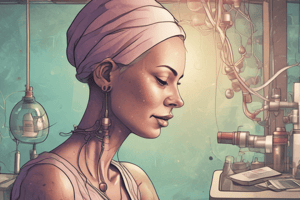Podcast
Questions and Answers
Which characteristic is NOT one of the hallmarks of cancer?
Which characteristic is NOT one of the hallmarks of cancer?
- Resisting cell death
- Inducing angiogenesis
- Initiating apoptosis (correct)
- Enabling replicative immortality
What is the primary limitation of chemotherapy?
What is the primary limitation of chemotherapy?
- Inability to induce angiogenesis
- Lack of targeted agents
- Total mass of the tumor (correct)
- Resistance to cell death
Which type of agents are classified as cytotoxic agents?
Which type of agents are classified as cytotoxic agents?
- Hormonal therapy
- Signal transduction inhibitors
- Agents that interfere with DNA synthesis (correct)
- Immunomodulators
What class do nitrogen mustards belong to?
What class do nitrogen mustards belong to?
Which of the following is a common side effect of chemotherapy?
Which of the following is a common side effect of chemotherapy?
What is the medical term for cancer or tumor?
What is the medical term for cancer or tumor?
Which of the following best describes a sarcoma?
Which of the following best describes a sarcoma?
What is the role of proto-oncogenes in normal cellular function?
What is the role of proto-oncogenes in normal cellular function?
What is the consequence of decreased activity of tumor suppressor genes?
What is the consequence of decreased activity of tumor suppressor genes?
Which of the following is NOT one of the hallmarks of cancer?
Which of the following is NOT one of the hallmarks of cancer?
Flashcards
What is cancer?
What is cancer?
An abnormal growth of tissue that can invade surrounding areas and spread to other parts of the body.
What are proto-oncogenes?
What are proto-oncogenes?
Genes that normally control cell growth and division. Mutations in these genes can lead to uncontrolled cell growth and cancer.
What are tumor suppressor genes?
What are tumor suppressor genes?
Genes that normally suppress or stop cell growth and division. Mutations or inactivation of these genes can contribute to cancer development.
What is metastasis?
What is metastasis?
Signup and view all the flashcards
What are the contributing factors to cancer?
What are the contributing factors to cancer?
Signup and view all the flashcards
DNA cross-linking agents
DNA cross-linking agents
Signup and view all the flashcards
Alkylating agents
Alkylating agents
Signup and view all the flashcards
Topoisomerase poisons
Topoisomerase poisons
Signup and view all the flashcards
Antibiotics in cancer treatment
Antibiotics in cancer treatment
Signup and view all the flashcards
Hormonal therapy
Hormonal therapy
Signup and view all the flashcards
Study Notes
Anticancer Agents
- Cancer is a collection of diseases characterized by abnormal cell growth and uncontrolled division.
- Neoplasms (tumors) can invade adjacent tissues (metastasis) making control difficult and potentially leading to patient death.
- Tumors can be named after the discoverer (Hodgkin's disease) or by the tissue of origin (sarcoma, carcinoma, fibroma, leukemia).
- Cancer etiology has several contributing factors but no single exact cause.
- Genetic factors (mutations and altered gene expression) are a contributing factor.
- Viruses such as HTLV-I are proven to cause certain types of leukemia.
- Exposure to chemicals and/or radiation are physical contributing factors.
- Hormonal factors can also contribute.
- The primary cause of cancer is believed to be incorrect proto-oncogene expression, leading to oncogene formation and unchecked cell growth.
- Tumor suppressor genes, like p53, help to regulate cell growth and prevent cancer formation. Their weakening or inactivation can promote cancer.
- Two fundamental genetic mechanisms for cancer include: either enhanced oncogene expression or decreased activity of tumour suppressor genes.
- Hallmarks of cancer represent six biological capabilities acquired during tumor development.
- They include: sustaining proliferative signaling, evading growth suppressors, resisting cell death, enabling replicative immortality, inducing angiogenesis, and activating invasion and metastasis.
- Cancer treatment options include surgery (if not metastasized), radiation therapy (effective at targeting tumors and minimizing surrounding damage), and chemotherapy (antineoplastic, cytotoxic, anticancer, and antitumor drugs).
- Chemotherapy is mainly limited by the size of the tumor.
- Common side effects of chemotherapy include nausea, hair loss, increased susceptibility to infection and others.
- Agents that inhibit or interfere with DNA synthesis or cell division are cytotoxic agents.
- Hormonal therapy is used for hormone-related cancers.
- Targeted anticancer therapeutics include signal transduction inhibitors (e.g., kinase inhibitors), immunomodulators, and epigenetic therapies.
- Cancer chemotherapeutics are categorized based on their chemical, pharmacological, and mechanistic profiles. These include DNA cross-linking agents (alkylating agents and organometallics), topoisomerase poisons, antibiotics, antimetabolites, hormone-based agents, signal transduction inhibitors, immunomodulators, and epigenetic therapies.
DNA Cross-linking Agents
- Alkylating agents are important early cancer treatments such as nitrogen mustards.
- These agents were first used after World War I when victims of sulfur mustard gas showed severe lymphoid aplasia and pulmonary irritation.
- Modern use is more limited, primarily for lymphomas and Hodgkin's disease.
- The nitrogen mustards, like Mechlorethamine, are bifunctional alkylating agents, reacting with guanine in DNA to cause cross-linking, halting mitosis and tumor cell division.
- Alkylating agents like Nitrosoureas and Treazines have high lipid solubility and a greater ability to cross the blood-brain barrier, making them useful for brain tumors.
- Further chemical modifications to nitrogen mustards allow them a broader application.
- Mechanisms of action include chemical decomposition yielding intermediates that alkylate DNA.
Topoisomerase Poisons
- Topoisomerases are enzymes controlling DNA supercoiling and play in DNA replication.
- Topoisomerase II poisons disrupt DNA, causing irreparable damage.
- Topoisomerase II poisons include Camptothecins, Epipodophyllotoxins, and Anthracyclines.
- Camptothecins, Epipodophyllotoxins, and Anthracyclines block or disrupt topoisomerases, halting DNA replication and promoting cell death.
Antibiotics (Anthracyclines)
- Anthracyclines are antibiotics extracted from Streptomyces bacteria.
- Doxorubicin and daunorubicin are critical anthracycline anticancer drugs with a planar anthraquinone core molecule attached to an amino sugar.
- They have a mechanism action involving binding to DNA and halting DNA replication, or interfering with topoisomerase processes.
Antimetabolites
- Antimetabolites stop de novo DNA synthesis by inhibiting the formation of essential nucleotides for DNA creation processes.
- Agents include pyrimidine (5-FU) and purine (6-Mercaptopurine, 6-Thioguanine) antagonists, DNA polymerase inhibitors, and DNA methyltransferase inhibitors.
- Pyrimidine antagonists obstruct dTMP synthesis, interfering with DNA synthesis.
- Purine antagonists block purine synthesis, curtailing the production of key nucleotides.
- Methotrexate acts as an antifolate, thus preventing the synthesis of tetrahydrofolic acid for thymidylate synthetase essential for DNA production in cells.
Mitosis Inhibitors
- Mitosis Inhibitors include Vinca alkaloids, which interrupt microtubule formation within cells preventing mitosis.
- Taxanes, like Paclitaxel, also disrupt mitosis but by acting on the spindle assembly part of the process.
Studying That Suits You
Use AI to generate personalized quizzes and flashcards to suit your learning preferences.
Related Documents
Description
Test your knowledge on the hallmarks of cancer and the limitations of chemotherapy. This quiz covers cytotoxic agents, their classifications, and common side effects experienced during chemotherapy treatments. Suitable for students studying medical or health sciences.





